

Rug Repair Techniques: Restoring the Beauty and Longevity of Your Rugs
Rugs add warmth, texture, and character to any space, but over time, they can suffer from wear and tear. Whether it’s a treasured family heirloom or a modern piece, knowing how to repair and maintain your rugs can extend their life and keep them looking beautiful for years to come. Here at HM Nabavian, we know how important it is to keep your rugs looking as good as new, here is a guide to some common rug repair techniques that can help restore your rug’s former glory.
1. Fringe Repair
The fringe on a rug is often the first area to show signs of wear. The constant foot traffic, vacuuming, and general use can cause the fringe to fray or unravel. Here’s how you can address fringe issues:
- Hand Knotting: For minor fringe damage, you can re-knot the fringes by hand. This involves tying off the remaining threads to prevent further unraveling. It’s a simple but effective way to maintain the integrity of the rug.
- Adding New Fringe: If the fringe is too damaged, consider adding new fringe. This can be done by attaching a new fringe to the edge of the rug, matching the original as closely as possible to maintain the rug’s aesthetic.
OB-6 Brushed Oriental Rug Fringe (Multiple Shades) - $2.06 Sold by the foot
2. Edge Binding
The edges of a rug can wear down over time, leading to fraying or the unraveling of threads. Edge binding is a common repair technique used to prevent further damage and restore the rug’s appearance:
- Hand Binding: For traditional or high-quality rugs, hand binding is the preferred method. This involves stitching a new binding onto the rug by hand, ensuring a durable and long-lasting repair.
- Machine Binding: For less valuable or modern rugs, machine binding is a quicker and more cost-effective solution. While not as durable or authentic as hand binding, it still provides adequate protection for the rug’s edges.
Rug Binding Tape (non-adhesive) - $4.75
3. Pile Repair
The pile of a rug can become worn down, torn, or even bald in certain areas due to heavy use or accidents. Repairing the pile is crucial to maintaining the rug’s look and feel:- Reweaving: Reweaving is a meticulous process where new fibers are woven into the rug to replace missing or damaged areas. This technique requires skill and precision, making it one of the more expensive repair options, but it can restore the rug to its original condition.
- Pile Shearing: If the pile is uneven or has become matted, pile shearing can be used to even out the surface. This technique involves carefully trimming the pile to a uniform height, giving the rug a refreshed appearance.
4. Hole Repair
Holes can develop in rugs due to various reasons, including moth damage, heavy wear, or accidents. Repairing holes is essential to prevent further deterioration:
- Patching: For small holes, patching can be an effective solution. A piece of fabric, often taken from an inconspicuous area of the rug, is sewn over the hole. This method is quick but may be noticeable depending on the rug’s pattern and age.
- Full Restoration: For larger or more significant damage, full restoration might be necessary. This involves reweaving the damaged area, replicating the original pattern and color. This process is complex and should be done by a professional.
5. Color Restoration
Over time, the colors in a rug can fade due to exposure to sunlight, spills, or aging. Restoring the color can bring life back to a faded rug:
- Color Touch-Up: For minor fading, a color touch-up can be done using specialized dyes to match the original colors. This technique can revive the rug’s vibrancy without altering its overall appearance.
- Full Re-Dyeing: In cases of significant fading or discoloration, full re-dyeing might be necessary. This involves carefully dyeing the entire rug to restore its original colors. This process requires expertise to ensure the rug’s pattern and hues remain consistent.
Restoration Yarns - Sample Shade Cards - $25.00
6. Cleaning and Maintenance
Regular cleaning and maintenance are key to preventing the need for extensive repairs. Here are some tips:
- Vacuuming: Regular vacuuming helps prevent dirt and debris from settling into the fibers, which can cause wear over time. Be gentle with the fringe and edges to avoid damage.
- Spot Cleaning: Address spills and stains immediately to prevent permanent damage. Use mild soap and water or a specialized rug cleaner, and blot the area instead of rubbing.
- Professional Cleaning: Periodic professional cleaning can remove deep-seated dirt and revitalize the rug. Professionals use techniques that are safe for your rug’s fibers and colors.

Conclusion
Rug repair is both an art and a science, requiring a keen eye for detail and a deep understanding of the rug’s materials and construction. While some minor repairs can be done at home, more significant damage often requires the expertise of a professional, if this is needed, please reach out to one of our team members at HM Nabavian. By addressing issues early and maintaining your rug properly, you can preserve its beauty and value for generations to come.








